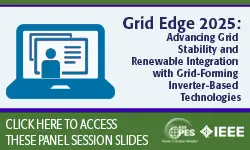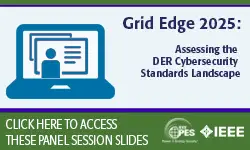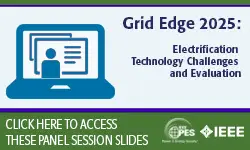-
Members: FreePES
IEEE Members: $25.00
Non-members: $40.00Pages/Slides: 62
Panel
13 Sep 2022
This panel session contains the following presentations:
1. Digital Control Bridge/Bridgeless PFC Converters with Modified Current Controller for ZCD Reduction
PFC converters built for telecom applications must meet certain standards in order to keep THD at the specified low levels to reduce the current stresses, reduce the power losses and hence increase the converter efficiency and input power factor (PF). Thus, in this paper, the small-signal stability models of the telecom bridge and bridgeless PFC converters are derived and based on the derived stability models, the fast-dynamic response IP current control technique is proposed to improve the control loops performance around the current waveform zero-crossing point, reduce zero crossing distortion (ZCD), reduce total harmonics distortion (THD), and reaches the input current PF near to unity. The digital simulation modeling using PSIM software of the 2.5 kW bridge and bridgeless PFC converters is performed to show the converter's performance with the proposed current technique as compared with the conventional PI control technique.
2. Laboratory Testbed for Advanced Grid Applications of Interconnected Battery Energy Storage Systems in Smart Grids
This paper presents a cyber-physical laboratory testbed based on a hierarchical control structure for education, research and development in the field of interconnected battery systems, implemented in the Smart Grid Laboratory at the University of Zagreb. The modular structure of the Smart Grid Laboratory's microgrid enables both the grid-connected and the off-grid operation, as well as hardware-in-the-loop simulations. The hierarchical control architecture enables a coordinated control of battery assets at several temporal scales. In this paper we present testbed use cases for developing distributed control algorithms for voltage and frequency control, and economically optimal centralized dispatch of the battery assets, as well as some concepts for developing educational activities for students.
3. Towards Realising Value of Internet of Energy (IoE) Application for Peer-To-Peer (P2P) Energy Trading: A PETRONAS Case Study
Internet of Energy (IoE) is a technology space where domains across power systems and end customers are connected via ubiquitous communication and digital technologies. One of the emerging technologies in IoE is Peer to Peer (P2P) energy trading, where it is premised on a sharing economy concept enabled by digital systems. PETRONAS through its Group Technical Solution (GTS) in collaboration with TNBX Sdn. Bhd. Berhad (TNBX) are planning to commence a Proof of Concept (PoC) for IoE P2P Project using actual case study in PETRONAS's Petrochemical Complex. IoE P2P is aspired to enable real-time energy generation and demand matching towards enriching electricity market focusing on Renewable Energy (RE). This paper discusses the challenges in terms of legislative, technical, and commercial aspects prior to the implementation of the PoC at PETRONAS Petrochemical Complex and highlights the expected value creation from the project.
4. Implementation of Advanced Real-Time Simulation Platform for Testing and Validation of PMU-Based Applications in Large-Scale Power System
This paper presents the implementation of an advanced real-time simulation platform as an effective approach for testing and validation of PMU-based applications. At present, many PMU-based applications, such as linear state estimator (LSE), is still in active development and have not been widely implemented in large-scale power systems as it requires the installation of a large number of PMUs to achieve a state estimator exclusively based on PMU measurements. To ensure the successful deployment of such a large-scale and complex system, it requires thorough testing and validation to evaluate its performance and reliability in different scenarios. However, the complexity of performing comprehensive system-level testing through large-scale integration of PMU devices with the interoperability of various smart grid applications remains a unique challenge making the functionality and performance of LSE in an operational power system environment difficult to fully evaluate and demonstrate. Therefore, the digital real-time power system simulator has enabled comprehensive real-time testing and validation of LSE to be implemented and analysis can be performed efficiently in different scenarios and grid conditions within a safe environment. The results indicate that the implementation of this advanced real-time simulation platform significantly reduces the time required to discover practical problems that arise and enables any rectification work to be determined and applied immediately, thus reducing the risk of system failure and enhancing the integrity of the PMU-based linear state estimator for actual system deployment.
1. Digital Control Bridge/Bridgeless PFC Converters with Modified Current Controller for ZCD Reduction
PFC converters built for telecom applications must meet certain standards in order to keep THD at the specified low levels to reduce the current stresses, reduce the power losses and hence increase the converter efficiency and input power factor (PF). Thus, in this paper, the small-signal stability models of the telecom bridge and bridgeless PFC converters are derived and based on the derived stability models, the fast-dynamic response IP current control technique is proposed to improve the control loops performance around the current waveform zero-crossing point, reduce zero crossing distortion (ZCD), reduce total harmonics distortion (THD), and reaches the input current PF near to unity. The digital simulation modeling using PSIM software of the 2.5 kW bridge and bridgeless PFC converters is performed to show the converter's performance with the proposed current technique as compared with the conventional PI control technique.
2. Laboratory Testbed for Advanced Grid Applications of Interconnected Battery Energy Storage Systems in Smart Grids
This paper presents a cyber-physical laboratory testbed based on a hierarchical control structure for education, research and development in the field of interconnected battery systems, implemented in the Smart Grid Laboratory at the University of Zagreb. The modular structure of the Smart Grid Laboratory's microgrid enables both the grid-connected and the off-grid operation, as well as hardware-in-the-loop simulations. The hierarchical control architecture enables a coordinated control of battery assets at several temporal scales. In this paper we present testbed use cases for developing distributed control algorithms for voltage and frequency control, and economically optimal centralized dispatch of the battery assets, as well as some concepts for developing educational activities for students.
3. Towards Realising Value of Internet of Energy (IoE) Application for Peer-To-Peer (P2P) Energy Trading: A PETRONAS Case Study
Internet of Energy (IoE) is a technology space where domains across power systems and end customers are connected via ubiquitous communication and digital technologies. One of the emerging technologies in IoE is Peer to Peer (P2P) energy trading, where it is premised on a sharing economy concept enabled by digital systems. PETRONAS through its Group Technical Solution (GTS) in collaboration with TNBX Sdn. Bhd. Berhad (TNBX) are planning to commence a Proof of Concept (PoC) for IoE P2P Project using actual case study in PETRONAS's Petrochemical Complex. IoE P2P is aspired to enable real-time energy generation and demand matching towards enriching electricity market focusing on Renewable Energy (RE). This paper discusses the challenges in terms of legislative, technical, and commercial aspects prior to the implementation of the PoC at PETRONAS Petrochemical Complex and highlights the expected value creation from the project.
4. Implementation of Advanced Real-Time Simulation Platform for Testing and Validation of PMU-Based Applications in Large-Scale Power System
This paper presents the implementation of an advanced real-time simulation platform as an effective approach for testing and validation of PMU-based applications. At present, many PMU-based applications, such as linear state estimator (LSE), is still in active development and have not been widely implemented in large-scale power systems as it requires the installation of a large number of PMUs to achieve a state estimator exclusively based on PMU measurements. To ensure the successful deployment of such a large-scale and complex system, it requires thorough testing and validation to evaluate its performance and reliability in different scenarios. However, the complexity of performing comprehensive system-level testing through large-scale integration of PMU devices with the interoperability of various smart grid applications remains a unique challenge making the functionality and performance of LSE in an operational power system environment difficult to fully evaluate and demonstrate. Therefore, the digital real-time power system simulator has enabled comprehensive real-time testing and validation of LSE to be implemented and analysis can be performed efficiently in different scenarios and grid conditions within a safe environment. The results indicate that the implementation of this advanced real-time simulation platform significantly reduces the time required to discover practical problems that arise and enables any rectification work to be determined and applied immediately, thus reducing the risk of system failure and enhancing the integrity of the PMU-based linear state estimator for actual system deployment.
Chairs:
Dr Chin Kim Gan


